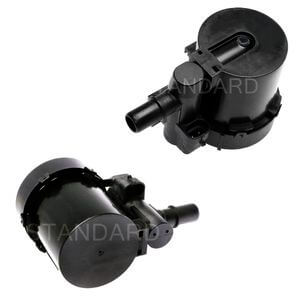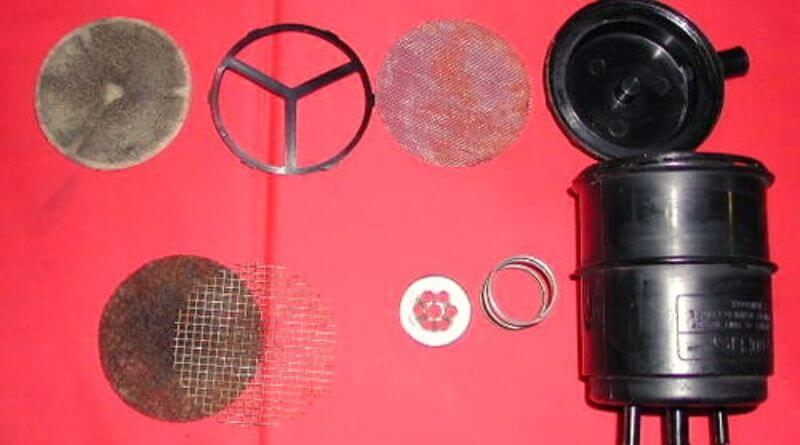Hey there! This post contains affiliate links to products. We may receive a commission for purchases made through these links. But it never influences our product selection process.
The charcoal canister is an integral feature of every EVAP system. A large surface area of pores and/or granules in activated carbon allows it to store fuel vapors effectively. Difficulties driving and saving gasoline are caused by faulty charcoal canisters. Regular charcoal canister cleaning can prevent these issues, and everyone must therefore know how to clean a charcoal canister.
Most of the Owners of vehicles know how to clean a power steering reservoir or how to fix a radiator leak with a JB weld, but they are less likely to know how to clean a clogged charcoal canister. Even those aware of the importance of cleaning their car’s charcoal canister may not know how to clean an evap canister or repair a charcoal canister. To proceed first, you need to know how to tell if an evap canister is bad or not. With the help of my professional experience as a technician, I’ve provided this guide in an attempt to educate you on how to properly clean a charcoal canister.
What is a Charcoal Canister?

To minimize emissions, charcoal canisters absorb vaporized fuel. Poisonous gases are recirculated back into the engine, making them less toxic. It is also known as an EVAP or vapour canister. So don’t be confused about what a vapour canister is? The Charcoal canister and the vapour canister are the same pieces of equipment, and it is essential to understand the purpose of the charcoal canister.
A charcoal canister in a car is an essential function that many drivers are unaware of. Consequently, cleaning the canister regularly is necessary to avoid a clog from developing, and you must first identify where it is located before cleaning it. In most cases, the charcoal vapour canister is found near the gas tank under the car. In many cases, it is hidden under plastic covers.
How Does a Charcoal Canister Work?
You already get a glimpse of what does a charcoal canister or vapour canister do. A canister prevents harmful vapours from entering the atmosphere, causing polluted air underneath the vehicle.
The canister has two ports, and the intake and outlet are automobile parts, and the purge valve also connects the tank’s inlet and output.
Charcoal is porous and has a huge surface area, and it also stores a lot of vapour fuel. Two vent and purge lines link the canister to the intake manifold.
When the engine is running, the piston stroke creates a pressure area in the manifold, which opens the purge valve, drawing fresh air into the bottom of the canister. In that case, Standard motor products CP455 fuel vapour canister works better.
The engine sucks in and burns air, and the purge valve only works at speeds over idle. The extra gasoline vapour may disturb the fuel mixture, resulting in poor idling and running.
How To Test a Charcoal Canister
The only way to determine how to tell if an evap canister is bad or not is by testing it. You can test the charcoal or vapour canister by following the below steps.
01. First, take out the charcoal canister;
02. Visually inspect the case of the charcoal canister for cracks or other damage;
03. Inspect for a clogged filter and a stuck check valve. Blow into the tank pipe with low-pressure compressed air to guarantee free airflow. Then blow into the purge pipe to clear any clogs
04. The charcoal canister should be cleaned or replaced if a problem is discovered. Remove the filter from the canister and clean it.
Using a 3 kg 43 psi air compressor, blow into the pipe leading to the outer vent control valve while keeping the other upper canister pipes closed, then clean the filter.
Symptoms of The Bad Charcoal Canister

Knowing the clogged charcoal canister symptoms in advance can help you promptly identify the problem. Below are some of the common symptoms:
Odorous Fuel:
You’ll notice a strong fuel smell near the vehicle’s rear or inside the cabin if your charcoal canister is faulty. Smelling these fumes for too long could make you sick.
Strong Emissions:
Using a defective charcoal canister will result in greater carbon emissions, and this issue may not be detected until an emissions test. Be informed whether your state requires this test every year or two.
Chunking Sound:
A clogged charcoal canister may alter the air/fuel mixture in the combustion chamber, resulting in odd engine beeping.
Various reasons can create these annoying sounds. If you have two or more of the symptoms, the charcoal canister is probably broken and has to be replaced.
Ineffectiveness:
Inefficient engine performance is a huge red flag. Incorrect carbon emission recirculation reduces engine power, resulting in engine damage.
Engine Check Light:
The engine check light ensures that your vehicle is free of any malfunctioning components. The engine check light will illuminate if the canister is malfunctioning.
Editor’s Choice

GM Genuine Parts 22963841 Vapor Canister
Automotive replacement parts manufacturer ACDelco is the leading supplier of GM Original Equipment (OE) components. Regarding quality, dependability, and longevity, GM Genuine Parts 22963841 Vapor Canister is one of them.
It meets GM OE fit, form, and function standards. L 13 x H 10 x W 5 inches are the measurements. This canister model fits different car models: 2004-2006 Cadillac Escalade ESV, Escalade EXT V8; Popular Fitments: 2016 2007-2009 Chevrolet Avalanche, 2006-2009 Chevrolet Suburban 1500, 2004-2006 Chevrolet Avalanche 1500, Suburban 1500.
Best Budget

Standard Motor Products CVS6 Vapor Canister Vent Solenoid
This canister vent solenoid is composed of durable industrial plastic. The factory is ISO/TS 14001 certified. The canister vent solenoid connectors and terminals match the engine wire harness. One-piece molding provides improved weather protection.
The dimension of the product is L 5 x H4.2 x W 5 inches. It’s a particular model-specific canister which is mainly designed for lightweight vehicles. Most of the Silverado users fit this in their car.
How To Clean a Charcoal Canister- Step By Step Guide

Clean a charcoal or evap canister by following this step-by-step guide. Also, following these steps will guide you on how to clean a sealed charcoal canister.
Step-1: Detach the Canister
Remove the charcoal canister from the car first. Depending on your car model, removing the canister from its mounting bracket is necessary.
Step-2: Attach a vacuum
Find a smooth surface to work on after removing the canister. Vacuum the canister to 50 psi. Unplug the vacuum when it hits 50 psi.
Step-3: Grip the top pipe
Then, hold up the upper vent of the canister. The top vent valve has a spring, unlike the intake and outlet valves.
Step-4: Turn on the vacuum pump
Block the intake and outflow valves with your fingertip while releasing up to 50 psi of air into the canister. Open the sealed canister using your finger.
Step-5: Let out the air
Inflate the control valve and check the outlet valve for proper airflow. This cleans and de-clogs the canister.
Step-6: Reinstall the canister
Then reinstall the canister after a thorough cleaning and checking for leaks.
How Long Does a Charcoal Canister Last
Most of them will last the car’s life and never need to be replaced. Problems with the evaporator canister filter may necessitate an emissions system inspection, and maybe you can just replace the filter. Mopar 5085164AA Evaporator Canister Filter has an easy mount and tub system that lasts longer.
How To Replace The Charcoal Canister
1) Lift up the car and set it on jack stands. Before crawling beneath a car, make sure it’s locked.
2)You may find it by the gas tank on the driver’s side. In front of the gas tank, it has many plastic fuel-line connections that are screwed together.
3)Remove the 3/8-inch ratchet and socket from the charcoal canister. Quickly remove the canister from the bracket.
Note: Repeat the steps in terms of f-150 charcoal canister removal.
Any More Questions?
Here are the most frequently asked questions regarding how to clean a clogged charcoal canister.
Can you bypass the charcoal canister?
It’s not a good idea to bypass the charcoal canister because it collects gas fumes and recycles them when you restart.
Can you drive with a bad canister purge valve?
Driving with a broken purge valve is feasible but not recommended. Driving with a defective valve increases the danger of harming the EVAP system and other parts.
How to clean the evap canister purge valve?
Remove the nut, separate the plunger from the coil, unscrew the plunger from the block, remove the magnetic plunger and spring. Clean all surfaces. Reassemble the purge valve to finish.
Can I drive with a faulty canister?
It is safe to drive for a short period with a faulty canister, but if it leaks, you should immediately take your automobile to a mechanic.
Closing Thoughts
The charcoal canister has a significant role in reducing pollution to the environment. As a result, all car owners should ensure they know how to clean a charcoal canister and how to replace it.
That’s all there is to cleaning a charcoal canister, and we hope you’ve learned something new. If you do, please tell others and write a remark for them. Boost your engine’s performance and efficiency while reducing flooding.
- Is The Jeep Cherokee Frame or Unibody (Briefly Answered) - November 10, 2022
- Are Titan Wheel Spacers Good (The 360 Guidelines) - November 9, 2022
- FCW off Jeep (Is It Important for Your Car) - November 9, 2022
